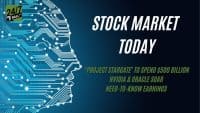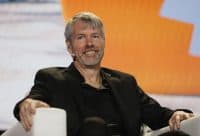 Steve Jobs’s transition from CEO of Apple (NASDAQ: AAPL) to chairman has caused a great deal of ink to be spilt on the departure of other famous CEOs, such as Walt Disney, Henry Ford, and Sam Walton. Very little has been said about the most innovative CEOs in America who are still in their jobs, some of whom have been for years.
Steve Jobs’s transition from CEO of Apple (NASDAQ: AAPL) to chairman has caused a great deal of ink to be spilt on the departure of other famous CEOs, such as Walt Disney, Henry Ford, and Sam Walton. Very little has been said about the most innovative CEOs in America who are still in their jobs, some of whom have been for years.
24/7 Wall St. looked at some of America’s most successful public corporations, both in terms of sales growth and stock prices improvement. We then selected companies where the CEO is the driving force behind that success. This judgment is subjective, but these chief executives are widely admired for their imaginations, ability to navigate varying economic conditions, and most important, their ability to take market share from all of their competitors.
Based on these criteria, many CEOs have been ruled out. Exxon Mobil may be the largest and most profitable oil company in the world, but CEO Rex Tillerson did not manage the merger that created the oil giant and has not pioneered crude discoveries or advancements in exploration. Intel continues to change the face of the chip business, but CEO Paul Otellini stands on the shoulders of Intel’s founders who invented the advanced chip industry and created Intel’s culture of innovation. Amgen is the world’s largest and most successful biotech company. CEO Kevin Sharer does not spend thousands of hours in the company’s labs.
The following are the leaders who revolutionized their companies, and to a great extent, their industries.
1. Netflix — Reed Hastings. The CEO of Netflix, Hastings, is only 50. He co-founded Netflix in 1998. The company’s first target was Blockbuster, the huge and highly profitable movie rental retail chain. Blockbuster had revenue of over $5 billion and nearly 6,000 stores when Netflix was founded. Hastings believed that it was more convenient for people, who watch DVDs at home, to receive them at home. He was right. Blockbuster is now bankrupt while Netflix has over 20 million subscribers.
But Hastings’s innovations did not stop there. As broadband technology developed and became widely spread in 2004 and 2005, Netflix used it to launch a business that allowed consumers to stream premium content from Netflix servers to their PCs. The service was upgraded two years later so the films and TV shows could be streamed straight to televisions.
Hastings has also set up deal to license content directly from studios, which poses a major threat to cable TV and telecom fiber-to-the-home businesses. Hastings changed the video rental, video delivery system, and premium content access infrastructure models, all within just 13 years. Netflix shares shot up 1000% in five years, a gain that’s even better than Apple’s.
2. Ford — Alan Mulally. Mulally has been Ford’s CEO since 2006 when he took the helm from William Clay Ford Jr., one of a long line of Fords who had run the car manufacturer. Mulally’s first contribution to one of the largest industries in the world was to prove that someone from outside the industry could run a car company better than those who had worked in it for decades. Even GM now has a new CEO who is new to the business. Mulally brought the discipline of a gifted general manager and treated Ford as a corporate clean sheet.
Mulally’s greatest accomplishment was likely the fact that Ford managed to avoid the eventual bankruptcy of the rest of the U.S. car industry. He did so by operating like an investment banker. Mulally increased Ford’s borrowing capacity to $23 billion just before the huge downturn in the economy. His actions were unprecedented. He pledged virtually all of Ford’s assets for access to the capital. Mulally then took the unusual step of pressing Washington to support his two primary competitors, GM and Chrysler. He knew that if either failed, Ford’s access to parts would be severely compromised.
Mulally also forced his engineers to view the car engine from different perspective. Ford’s engineers created a new technology which could give a four cylinder engine the power of six, and a six cylinder the power of an eight. This could be done without hybrid technology or diesel. EconoBoost engine was born, and since 2007 it has powered many of the company’s models.
3. Amazon — Jeff Bezos. Amazon’s CEO and founder, only 47-years-old, started that company to compete with brick-and mortar-bookstores. That was in 1994. At the time, the move was a long shot. E-commerce was almost unheard of and untested. Wide broadband adoption was a decade away. Bezos was not profit-hungry. He said shortly after Amazon was founded that he was prepared for it to lose money for three or four years. Bezos was convinced it would take that long for Amazon to reach the critical mass of sales to sustain the company’s model over the long term.
Bezos later decided that Amazon could sell more than books to its growing customer base. Rather than buying inventory and selling products he did not understand well, he allowed “affiliates” to market their goods and services using Amazon.com’s infrastructure. Amazon eventually created its own businesses to market goods and services, from beauty products to furniture to consumer electronics. With each case, he added to Amazon’s revenue by attacking the tradition store models of companies like Best Buy.
The most important invention made by Amazon, the Kindle e-reader, took it back to its bookstore roots. The new consumer electronics device and the Amazon’s inventory of e-books made the physical books unnecessary. Consumers could download thousands and thousands of books and “carry” them around in their devices, whose is often less than that of one large book. Amazon does not disclose Kindle sales, but analysts put them into the millions and say that the number of Kindles sold each quarter continues to grow.
4. Berkshire Hathaway — Warren Buffett. The “greatest investor in history” did not change American business. Buffett, however, created the largest mutual fund in the world, with him alone making the investment decisions. The Oracle of Omaha buys some companies outright. He buys large amounts of stock in other companies. With others yet, he loans money in the form of bonds.
Buffett now owns one of the largest railroads in the world, Burlington Northern, which he took private two years ago. He controls several insurance and re-insurance companies, including Geico and General Re. Buffett also takes friendly positions from time to time in America’s blue chip companies and sells them without notice when he believes he has either made or lost enough money. These investments have included Coca Cola, American Express, CostCo, Bank of America, GE, MasterCard, and Walmart.
Buffett has also perfected a form of financing that is unique to him, primarily because of his reputation. He can quickly take position in troubled companies as he did in Goldman Sachs and Bank of America. He insists on terms that trade his reputation for agreements, and that make his investments almost immediately profitable. Buffett’s gift may be investing, but his revolutionary move was to create the world’s largest one-man conglomerate and make it work almost perfectly.
5. Facebook — Mark Zuckerburg. Zuckerburg is 27 now. He started the world’s largest social network when he was 20. Facebook currently has over 700 million members, and most internet investment analysts believe the company is worth close to $100 billion. Facebook’s revenue in 2010 was nearly $2 billion, and the company makes a profit, no mean feat for an operation that is growing as quickly as it has.
Zuckerburg’s great innovation was to understand that people would rather see one another online than look at third party content. People would rather see friends and family than news or search engine results. He may not have discovered that people often found other people more important than content, but he was the first to build a huge business on the premise
Zuckerburg faced strong competition when he entered the social network business. MySpace was by far the largest social network in the world. It was owned by, and had the backing of one of, the world’s largest media companies — Rupert Murdoch’s News Corp. How he managed to do it is still somewhat of a mystery. That makes him in many ways like Steve Jobs, who designed and marketed products better than already existing similar competing products. One explanation is that Facebook was restricted to use by college and high school users in its early stages. Young people tend to use the Internet more than older people.
Zuckerburg has also been able to do two other difficult things. He has gotten his users to accept a certain loss of privacy in exchange for free use of Facebook. He has also created the largest display advertising platform in the U.S. by convincing major marketers that social networks are advertising friendly and not platforms for the ridicule and attack of large companies.
6. McDonald’s — Jim Skinner. Skinner has been the CEO of McDonald’s since 2004. He has been with the world’s largest fast food chain since 1971 when he joined as a management trainee. McDonald’s growth had stalled when Skinner became the chief executive. The stock price in 2005 was below where it was in 1999. For the three decades before that, McDonald’s shares moved from $1 in 1974 to $45 in 1998.
Skinner faced a range of competitors that McDonald’s had never had before. Burger King was gaining on it in the traditional hamburger business. Pizza fast food operations were growing quickly, and offered home delivery. Subway became a major fast food presence in the early 2000s, and one that offered fresh food. Several Mexican restaurant chains grew quickly as well. And traditional competitors Kentucky Fried Chicken and Dunkin Donuts were still doing well.
Skinner made two key decisions. The first was to make breakfast the core meal for McDonald’s customers. Before that, it was a lunch and dinner business. Among them the nation’s thousands of diners, Dunkin’ Donuts, and Starbucks had tremendous revenue. McDonald’s created an expansive morning menu and sold high-end coffee at low prices. It also began to keep many of its restaurants open all night so that people could have either very late dinners or very early breakfast.
Skinner also decided that China was critical to the company’s growth and that the McDonald’s U.S. menu travelled well. Rather than trying to sell Chinese food at McDonald’s, McDonald’s sold hamburger and fries everywhere else. China is now one of the company’s three key markets along with Europe and the U.S.
7. Twitter — Jack Dorsey. Jack Dorsey started Twitter in 2006, well after the social media sector became crowded. There was nothing new about allowing people universal access to their friends and families. Twitter’s revolutionary move was to allow people to “speak” to each other in a sentence or two.
Twitter made communications compact and discussions of just a few words acceptable. That accomplished two things. It made social network activity more portable. Tweets were no longer than text messages. It also made social network communications easy on portable mobile devices, even inexpensive handsets.
Twitter built a network of 200 million users with several clever marketing decisions. It encouraged politicians and celebrities to develop a large following on Twitter. In exchange, they could communicate instantly with millions, whether to get votes or sell movie tickets.
Twitter became an e-commerce platform without its users viewing it as exploitative at all. Communications via letter was ungainly and took days. Telephone conversations were often long and expensive. E-mail was not instant. Twitter changed all of that. People could contact each other instantly and had to learn a way to make communication brief. They could use those brief message to reach more people than ever before—all 200 million of them.
Douglas A. McIntyre
Are You Ahead, or Behind on Retirement? (sponsor)
If you’re one of the over 4 Million Americans set to retire this year, you may want to pay attention. Many people have worked their whole lives preparing to retire without ever knowing the answer to the most important question: are you ahead, or behind on your retirement goals?
Don’t make the same mistake. It’s an easy question to answer. A quick conversation with a financial advisor can help you unpack your savings, spending, and goals for your money. With SmartAsset’s free tool, you can connect with vetted financial advisors in minutes.
Why wait? Click here to get started today!
Thank you for reading! Have some feedback for us?
Contact the 24/7 Wall St. editorial team.





